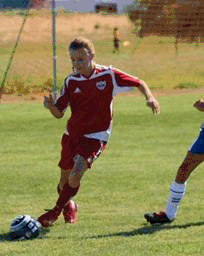Life come full circle
 This week I join UCDavis Sports Medicine and California State University Sacramento in a joint research project to polish, a currently under research, conditioning and injury prevention program. The ultimate objective is to help resolve the high non-contact lower extremity injury rates among high school girl team sport athletes.
This week I join UCDavis Sports Medicine and California State University Sacramento in a joint research project to polish, a currently under research, conditioning and injury prevention program. The ultimate objective is to help resolve the high non-contact lower extremity injury rates among high school girl team sport athletes.
I was a promising, All-Metro soccer player at St. Francis High School in Sacramento. I suffered a knee injury going up for a header and landing. The injury certainly was not the end of the world, but it did change the course of my life.
Fast forward to present, when last year I had the opportunity to study, over an extended period, with Dr. Chris Powers at his recently opened, USC-affiliated Movement Performance Institute (MPI). As a result of over 12 years of research and recent in-lab testing – Dr. Powers has scientifically identified leading factors in lower extremity injuries. Based on these research derived findings, Powers has developed a proven, systematic return to sport, injury prevention and enhanced performance protocol – he is considered one of the world’s leading authorities in knee injuries.
Initially, my motivation to study with Powers was to understand the mystery of the injured runner. I was frustrated by the analysis and treatment that seemed a shotgun, guesswork approach and often based on the latest magazine article professing a quick fix fad or promoting a product.
Dr. Powers return to sport, injury prevention and performance enhancement program supports runners and cyclists as well as team sport athletes.
While studying at MPI, I realized the prevalence of non-contact, lower extremity injuries, among high school athletes, especially significant among girls. While my initial motivation was the injured runner, my attention started gravitating to the high school girl, team athlete, as there seemed to be a void in science-based, effective injury prevention conditioning programs.
When I completed my study with Powers – I researched several high school girls athletic programs, to better understand the conditioning programs in place. I found that most girls with financial means hired personal trainers, while others were encouraged to attend CrossFit. I was discouraged. It seemed to me the girls who depend on the athletic scholarships for their college education, could not afford a personal trainer, nor could they afford an injury. And in my experience, CrossFit has proven job security for orthopedics as well as physical therapists.
Motivated by my experience as an injured high school athlete, my study at MPI and understanding what is currently available at the high school level, I approached UCDavis Sports Med. I proposed a community outreach program to ultimately provide a science-based, proven and effective injury prevention conditioning program implemented at high schools, accessible to all athletes.
The stars seemed to align as UCDavis Sports Med, head researcher Dr. Casazza had an injury prevention program under research. After meeting we realized that there was an opportunity to polish the effectiveness of the existing program with my knowledge.
One of the prime objectives of the research project is to develop an effective, efficient injury prevention conditioning program that can be realistically implemented within the confines of time constrained high school athletics. Additionally, this project will result in a program to train coaches to identify injury risk factors and equip them with the activation, strength and movement training strategies to address these factors. The ultimate goal is to coin this program and make it accessible to high schools region-wide for implementation.




